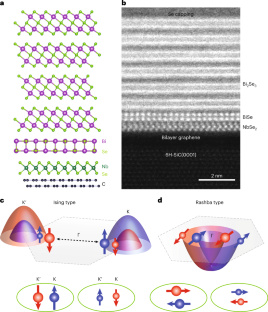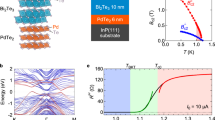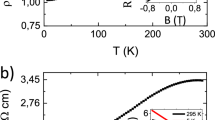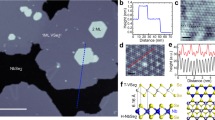Abstract
A topological insulator (TI) interfaced with an s-wave superconductor has been predicted to host topological superconductivity. Although the growth of epitaxial TI films on s-wave superconductors has been achieved by molecular-beam epitaxy, it remains an outstanding challenge for synthesizing atomically thin TI/superconductor heterostructures, which are critical for engineering the topological superconducting phase. Here we used molecular-beam epitaxy to grow Bi2Se3 films with a controlled thickness on monolayer NbSe2 and performed in situ angle-resolved photoemission spectroscopy and ex situ magnetotransport measurements on these heterostructures. We found that the emergence of Rashba-type bulk quantum-well bands and spin-non-degenerate surface states coincides with a marked suppression of the in-plane upper critical magnetic field of the superconductivity in Bi2Se3/monolayer NbSe2 heterostructures. This is a signature of a crossover from Ising- to Rashba-type superconducting pairings, induced by altering the Bi2Se3 film thickness. Our work opens a route for exploring a robust topological superconducting phase in TI/Ising superconductor heterostructures.
This is a preview of subscription content, access via your institution
Access options
Access Nature and 54 other Nature Portfolio journals
Get Nature+, our best-value online-access subscription
$29.99 / 30 days
cancel any time
Subscribe to this journal
Receive 12 print issues and online access
$259.00 per year
only $21.58 per issue
Buy this article
- Purchase on Springer Link
- Instant access to full article PDF
Prices may be subject to local taxes which are calculated during checkout




Similar content being viewed by others
Data availability
The datasets generated during and/or analysed during this study are available from the corresponding author upon reasonable request.
Code availability
The codes used in the theoretical simulations and calculations are available from the corresponding author upon reasonable request.
References
Fu, L. & Kane, C. L. Superconducting proximity effect and Majorana fermions at the surface of a topological insulator. Phys. Rev. Lett. 100, 096407 (2008).
Wang, M. X. et al. The coexistence of superconductivity and topological order in the Bi2Se3 thin films. Science 336, 52–55 (2012).
Xu, S. Y. et al. Momentum-space imaging of Cooper pairing in a half-Dirac-gas topological superconductor. Nat. Phys. 10, 943–950 (2014).
Xu, J. P. et al. Artificial topological superconductor by the proximity effect. Phys. Rev. Lett. 112, 217001 (2014).
Xu, J. P. et al. Experimental detection of a Majorana mode in the core of a magnetic vortex inside a topological insulator-superconductor Bi2Te3/NbSe2 heterostructure. Phys. Rev. Lett. 114, 017001 (2015).
Sun, H. H. et al. Majorana zero mode detected with spin selective Andreev reflection in the vortex of a topological superconductor. Phys. Rev. Lett. 116, 257003 (2016).
Zhu, Z. et al. Discovery of segmented Fermi surface induced by Cooper pair momentum. Science 374, 1381–1385 (2021).
Xi, X. X. et al. Ising pairing in superconducting NbSe2 atomic layers. Nat. Phys. 12, 139–143 (2016).
Xing, Y. et al. Ising superconductivity and quantum phase transition in macro-size monolayer NbSe2. Nano Lett. 17, 6802–6807 (2017).
Hsu, Y. T., Vaezi, A., Fischer, M. H. & Kim, E. A. Topological superconductivity in monolayer transition metal dichalcogenides. Nat. Commun. 8, 14985 (2017).
Xu, G., Wang, J., Yan, B. H. & Qi, X. L. Topological superconductivity at the edge of transition-metal dichalcogenides. Phys. Rev. B 90, 100505 (2014).
Zhou, B. T., Yuan, N. F. Q., Jiang, H. L. & Law, K. T. Ising superconductivity and Majorana fermions in transition-metal dichalcogenides. Phys. Rev. B 93, 180501 (2016).
Chang, C. Z. et al. Growth of quantum well films of topological insulator Bi2Se3 on insulating substrate. SPIN 1, 21–25 (2011).
Zhang, Y. et al. Crossover of the three-dimensional topological insulator Bi2Se3 to the two-dimensional limit. Nat. Phys. 6, 584–588 (2010).
Sakamoto, Y., Hirahara, T., Miyazaki, H., Kimura, S. & Hasegawa, S. Spectroscopic evidence of a topological quantum phase transition in ultrathin Bi2Se3 films. Phys. Rev. B 81, 165432 (2010).
Yokoya, T. et al. Fermi surface sheet-dependent superconductivity in 2H-NbSe2. Science 294, 2518–2520 (2001).
Zhang, H. J. et al. Topological insulators in Bi2Se3, Bi2Te3 and Sb2Te3 with a single Dirac cone on the surface. Nat. Phys. 5, 438–442 (2009).
Xia, Y. et al. Observation of a large-gap topological-insulator class with a single Dirac cone on the surface. Nat. Phys. 5, 398–402 (2009).
Wang, M. X. et al. Interface structure of a topological insulator/superconductor heterostructure. New J. Phys. 16, 123043 (2014).
Ugeda, M. M. et al. Characterization of collective ground states in single-layer NbSe2. Nat. Phys. 12, 92–97 (2016).
Xu, C. Z. et al. Experimental and theoretical electronic structure and symmetry effects in ultrathin NbSe2 films. Phys. Rev. Mater. 2, 064002 (2018).
Liu, C. X. et al. Oscillatory crossover from two-dimensional to three-dimensional topological insulators. Phys. Rev. B 81, 041307 (2010).
Sattar, S. & Larsson, J. A. Tunable electronic properties and large Rashba splittings found in few-layer Bi2Se3/PtSe2 van der Waals heterostructures. ACS Appl. Electron. Mater. 2, 3585–3592 (2020).
Zhu, Z. H. et al. Rashba spin-splitting control at the surface of the topological insulator Bi2Se3. Phys. Rev. Lett. 107, 186405 (2011).
Valla, T., Pan, Z. H., Gardner, D., Lee, Y. S. & Chu, S. Photoemission spectroscopy of magnetic and nonmagnetic impurities on the surface of the Bi2Se3 topological insulator. Phys. Rev. Lett. 108, 117601 (2012).
King, P. D. C. et al. Large tunable Rashba spin splitting of a two-dimensional electron gas in Bi2Se3. Phys. Rev. Lett. 107, 096802 (2011).
Bahramy, M. S. et al. Emergent quantum confinement at topological insulator surfaces. Nat. Commun. 3, 1159 (2012).
Buzdin, A. I. Proximity effects in superconductor-ferromagnet heterostructures. Rev. Mod. Phys. 77, 935–976 (2005).
Wördenweber, R., Moshchalkov, V. V., Bending, S. J. & Tafuri, F. Superconductors at the Nanoscale: From Basic Research to Applications (de Gruyter, 2017).
Xi, X. X., Berger, H., Forro, L., Shan, J. & Mak, K. F. Gate tuning of electronic phase transitions in two-dimensional NbSe2. Phys. Rev. Lett. 117, 106801 (2016).
Ruggiero, S. T., Barbee, T. W. & Beasley, M. R. Superconductivity in quasi-two-dimensional layered composites. Phys. Rev. Lett. 45, 1299–1302 (1980).
Yoshizawa, S. et al. Atomic-layer Rashba-type superconductor protected by dynamic spin-momentum locking. Nat. Commun. 12, 1462 (2021).
Lu, J. M. et al. Evidence for two-dimensional Ising superconductivity in gated MoS2. Science 350, 1353–1357 (2015).
Perdew, J. P., Burke, K. & Ernzerhof, M. Generalized gradient approximation made simple. Phys. Rev. Lett. 77, 3865–3868 (1996).
Blöhl, P. E. Projector augmented-wave method. Phys. Rev. B 50, 17953–17979 (1994).
Kresse, G. & Furthmuller, J. Efficient iterative schemes for ab initio total-energy calculations using a plane-wave basis set. Phys. Rev. B 54, 11169–11186 (1996).
Grimme, S., Antony, J., Ehrlich, S. & Krieg, H. A consistent and accurate ab initio parametrization of density functional dispersion correction (DFT-D) for the 94 elements H-Pu. J. Chem. Phys. 132, 154104 (2010).
Sigrist, M. & Ueda, K. Phenomenological theory of unconventional superconductivity. Rev. Mod. Phys. 63, 239–311 (1991).
Acknowledgements
We thank Y. Cui, K. T. Law and D. Xiao for helpful discussions. This work is primarily supported by the Penn State MRSEC for Nanoscale Science (DMR-2011839) (H.Y. and C.-Z.C.). The electrical transport measurements and sample characterization are partially supported by the NSF CAREER award (DMR-1847811) (C.-Z.C.). The theoretical calculations and simulations are partially supported by a DOE grant (DE-SC0019064) (C.-X.L.). Y.W. acknowledges support from a startup grant from the University of North Texas. The MBE growth and ARPES measurements were performed in the NSF-supported 2DCC MIP facility (DMR-2039351) (N.S. and C.-Z.C.). The dilution refrigerator transport measurements at University of Washington are supported by the AFOSR award (FA9550-21-1-0177) (X.X.) and acknowledge the usage of the millikelvin optoelectronic quantum material laboratory supported by the M. J. Murdock Charitable Trust. D.R.H. and N.A. acknowledge support from the NSF CAREER award (DMR-1654107). C.-Z.C. also acknowledges support from the Gordon and Betty Moore Foundation’s EPiQS Initiative (grant GBMF9063 to C.-Z.C.).
Author information
Authors and Affiliations
Contributions
C.-Z.C. conceived and designed the experiment. H.Y. performed the MBE growth and ARPES measurements and used the physical property measurement system with the help of Y.-F.Z., L.-J.Z., R.Z., A.R.R., M.H.W.C., N.S. and C.-Z.C. R.X. and H.Y. performed the 3He transport measurements with the help of N.S. and C.-Z.C. J.C. and X.X. performed the dilution transport measurements. Y.W. performed the first-principles calculations. C.D. and J.A.R. prepared the bilayer graphene-terminated 6H-SiC(0001) substrates. D.R.H. and N.A. carried out the TEM measurements. L.-H.H. and C.-X.L. performed the theoretical simulations. H.Y., L.-H.H., Y.W. and C.-Z.C. analysed the data and wrote the manuscript with inputs from all the authors.
Corresponding author
Ethics declarations
Competing interests
The authors declare no competing interests.
Peer review
Peer review information
Nature Materials thanks Jinfeng Jia and the other, anonymous, reviewer(s) for their contribution to the peer review of this work.
Additional information
Publisher’s note Springer Nature remains neutral with regard to jurisdictional claims in published maps and institutional affiliations.
Extended data
Extended Data Fig. 1 RHEED patterns during MBE growth.
(a) Bilayer graphene terminated 6H-SiC(0001) substrate. (b) Monolayer NbSe2 film grown on bilayer graphene. (c) 5 QL Bi2Se3/monolayer NbSe2 heterostructure grown on bilayer graphene.
Extended Data Fig. 2 Cross-sectional ADF-STEM images and EDS maps of the MBE-grown Bi2Se3/monolayer NbSe2 heterostructure.
(a–c) ADF-STEM images of the Bi2Se3/monolayer NbSe2 heterostructure along different orientations. (d,e) Large-scale ADF-STEM image and corresponding EDS maps of Si, Nb, Bi, and Se of the Se layer-capped 6QL Bi2Se3/monolayer NbSe2 heterostructure grown on bilayer graphene terminated 6H-SiC(0001).
Extended Data Fig. 3 Electronic band structures of monolayer NbSe2 and 1QL Bi2Se3/monolayer NbSe2.
(a) Fermi surface of monolayer NbSe2. (b) Fermi surface of 1QL Bi2Se3/monolayer NbSe2. The red dashed lines in (a) and (b) locate the hole pocket near the Γ point from monolayer NbSe2. The blue dashed line in (b) locates the electron pocket near the Γ point from 1QL Bi2Se3. (c, d) ARPES band maps of monolayer NbSe2 and 1QL Bi2Se3/monolayer NbSe2. (e) Comparison of the energy distribution curves at the Γ point in monolayer NbSe2 (red line) and 1QL Bi2Se3/monolayer NbSe2(blue line).
Extended Data Fig. 4 Rashba-type bulk QW bands and Dirac SSs in mQL Bi2Se3/monolayer NbSe2 heterostructures.
(a-e) The second derivative spectra of the ARPES data in Fig. 2b–f of the main text. (f) Rashba splitting parameter αR of QW1 and QW2 states as a function of m.
Extended Data Fig. 5 Ising-type superconductivity in monolayer NbSe2.
(a) R-T curves of monolayer NbSe2 under different out-of-plane magnetic fields \(\mu _0H_ \bot\). (b) R-T curves of monolayer NbSe2 under different in-plane magnetic fields \(\mu _0H_\parallel\). (c) Hc2-T phase diagram of monolayer NbSe2.
Extended Data Fig. 6 R-μ0H curves of mQL Bi2Se3/monolayer NbSe2 heterostructures under in-plane magnetic fields at different temperatures.
(a) m=1. (b) m=2. (c) m=3. (d) m=4. (e) m=5. (f) m=6.
Extended Data Fig. 7 R-μ0H curves of monolayer NbSe2 and mQL Bi2Se3/NbSe2 heterostructures under out-of-plane magnetic fields at different temperatures.
(a) Monolayer NbSe2. (b) m=1. (c) m=2. (d) m=6.
Extended Data Fig. 8 Estimation of the charge transfer between monolayer NbSe2 and BiSe.
(a) Side view of calculation supercell for \(\sqrt 2 \times 4\sqrt 2\) BiSe on \(\sqrt 3 \times 7\) NbSe2. (b) Projected band structures of BiSe/monolayer NbSe2 (left) and freestanding monolayer NbSe2 (right). The projections of total wavefunction onto Nb orbitals and Bi orbitals are shown in red and blue, respectively.
Extended Data Fig. 9 (m–1) bulk QW states in mQL Bi2Se3 films.
The calculated electronic band structures of freestanding mQL Bi2Se3 films with 2 ≤ m ≤ 6.
Extended Data Fig. 10 Bulk QW states in a freestanding 4QL Bi2Se3 film.
Partial charge densities for QW1, QW2, and QW3 in freestanding 4QL Bi2Se3 films, accompanied with their xy-plane-averaged representations ρxy(z) plotted in the same way as Fig. 4g in the main text. Black curves are schematics for the charge densities of the envelope wavefunctions.
Supplementary information
Supplementary Information
Supplementary text for Extended Data Figs. 1–10, Figs. 1–6 and accompanying text and references.
Rights and permissions
Springer Nature or its licensor holds exclusive rights to this article under a publishing agreement with the author(s) or other rightsholder(s); author self-archiving of the accepted manuscript version of this article is solely governed by the terms of such publishing agreement and applicable law.
About this article
Cite this article
Yi, H., Hu, LH., Wang, Y. et al. Crossover from Ising- to Rashba-type superconductivity in epitaxial Bi2Se3/monolayer NbSe2 heterostructures. Nat. Mater. 21, 1366–1372 (2022). https://doi.org/10.1038/s41563-022-01386-z
Received:
Accepted:
Published:
Issue Date:
DOI: https://doi.org/10.1038/s41563-022-01386-z
This article is cited by
-
The superconducting diode effect
Nature Reviews Physics (2023)
-
Electron-phonon coupling and spin fluctuations in the Ising superconductor NbSe2
npj Computational Materials (2023)
-
Dirac-fermion-assisted interfacial superconductivity in epitaxial topological-insulator/iron-chalcogenide heterostructures
Nature Communications (2023)
-
Stack growth of wafer-scale van der Waals superconductor heterostructures
Nature (2023)



